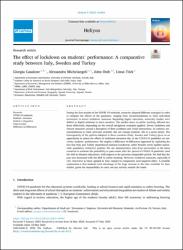| dc.contributor.author | Casalone, Giorgia | |
| dc.contributor.author | Michelangeli, Alessandra | |
| dc.contributor.author | Östh, John | |
| dc.contributor.author | Türk, Umut | |
| dc.date.accessioned | 2024-02-21T07:05:03Z | |
| dc.date.available | 2024-02-21T07:05:03Z | |
| dc.date.issued | 2023 | en_US |
| dc.identifier.issn | 2405-8440 | |
| dc.identifier.other | WOS:001019375700001 | |
| dc.identifier.uri | https://doi.org/10.1016/j.heliyon.2023.e16464 | |
| dc.identifier.uri | https://hdl.handle.net/20.500.12573/1951 | |
| dc.description.abstract | During the first months of the COVID-19 outbreak, countries adopted different strategies in order to mitigate the effects of the pandemic, ranging from recommendations to limit individual movement to severe lockdown measures. Regarding higher education, university studies were shifted to digital solutions in most countries. The sudden move to online teaching affected stu-dents differently, depending on the overall mitigation strategies applied. Severe lockdown and closure measures caused a disruption of their academic and social interactions. In contrast, rec-ommendations to limit activities probably did not change students' life to a great extent. The heterogeneity of the policies adopted in three countries (Italy, Sweden and Turkey) gives us an opportunity to assess the effects of lockdown measures due to the COVID-19 pandemic on uni-versity students' performance. We employ a difference-in-differences approach by exploiting the fact that Italy and Turkey experienced national lockdowns, while Sweden never applied nation-wide mandatory restrictive policies. We use administrative data from universities in the three countries to estimate the probability to pass exams after the spread of COVID-19 pandemic (and the shift to distance education), with respect to the previous comparable period. We find that the pass rate decreased with the shift to online teaching. However, lockdown measures, especially if very restrictive as those applied in Italy, helped to compensate such negative effect. A possible explanation is that students took advantage of the huge increase in the time available for their studies, given the impossibility to carry out any activity outside the home. | en_US |
| dc.language.iso | eng | en_US |
| dc.publisher | ELSEVIER SCI LTD | en_US |
| dc.relation.isversionof | 10.1016/j.heliyon.2023.e16464 | en_US |
| dc.rights | info:eu-repo/semantics/openAccess | en_US |
| dc.subject | COVID-19 pandemic | en_US |
| dc.subject | Students’ outcomes | en_US |
| dc.subject | Student’s integration | en_US |
| dc.subject | Time-to-study | en_US |
| dc.subject | Difference-in-Differences | en_US |
| dc.title | The effect of lockdown on students' performance: A comparative study between Italy, Sweden and Turkey | en_US |
| dc.type | article | en_US |
| dc.contributor.department | AGÜ, Yönetim Bilimleri Fakültesi, Ekonomi Bölümü | en_US |
| dc.contributor.authorID | 0000-0002-8440-7048 | en_US |
| dc.contributor.institutionauthor | Türk, Umut | |
| dc.identifier.volume | 9 | en_US |
| dc.identifier.issue | 6 | en_US |
| dc.identifier.startpage | 1 | en_US |
| dc.identifier.endpage | 13 | en_US |
| dc.relation.journal | HELIYON | en_US |
| dc.relation.tubitak | 120K273 | |
| dc.relation.publicationcategory | Makale - Uluslararası Hakemli Dergi - Kurum Öğretim Elemanı | en_US |


















